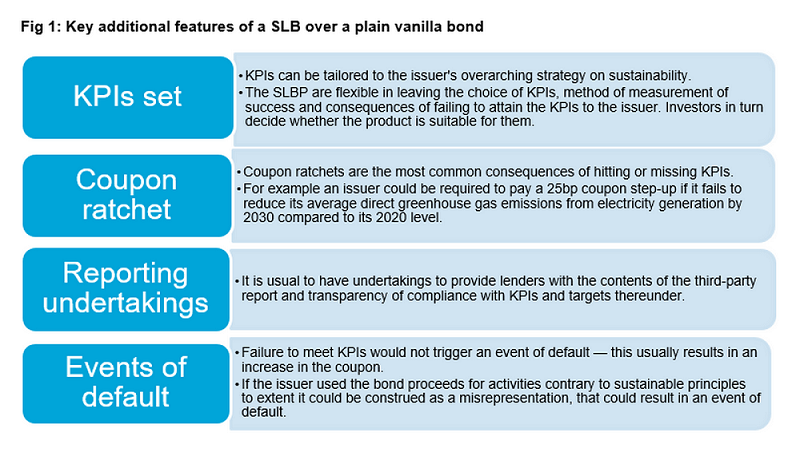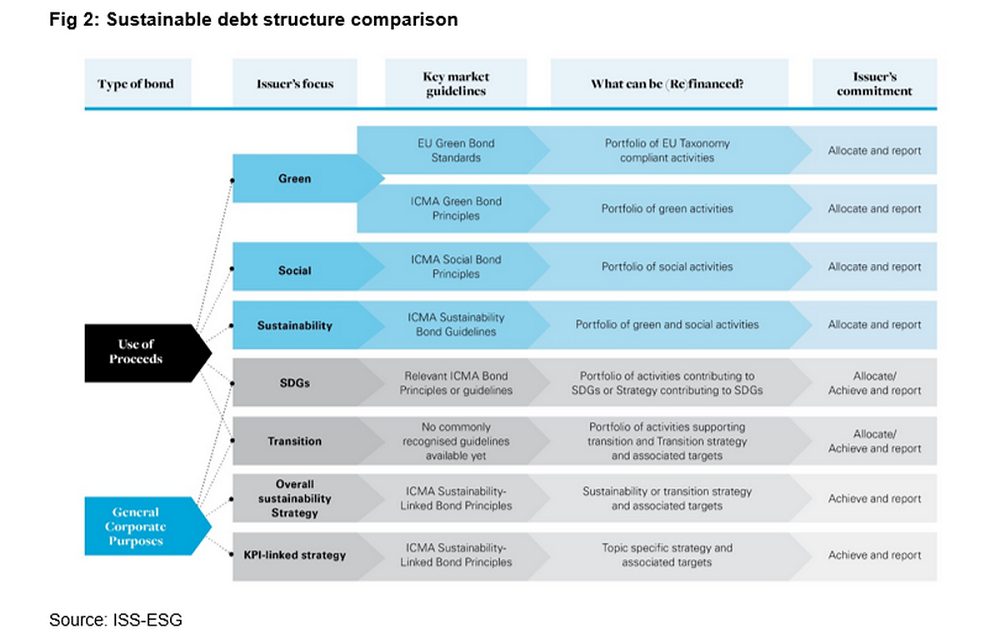
In the wake of the unprecedented success of sustainability-linked loans, the concept of linking a debt instrument to sustainability performance and its utility was quickly adopted by the bond market with the creation of sustainability-linked bonds ("SLBs"), and the publication of ICMA's Sustainability-Linked Bond Principles ("SLBPs").1
To date, most sustainable debt capital markets issuances have been aligned with the Green Bond Principles ("GBP"),2 which are designed on a use of proceeds model for funding dedicated sustainable projects. Unlike green and social bonds, the proceeds of SLBs may be used for general corporate purposes rather than for specific sustainable projects. SLBs could therefore prove a useful alternative sustainable finance product to issuers who have not been able to issue a green or social bond.
What does "sustainability-linked" mean?
SLBs are debt securities which are generally structured like standard "plain vanilla" bonds, but with some notable additional features. While setting up the bond, the issuer agrees a number of sustainability-related targets (key performance indicators ("KPIs")), such as reducing greenhouse gas emissions to a certain level, increasing usage of renewable energy to a certain proportion, or achieving a certain 'sustainability rating' from an external rating provider, within a certain time period. The attributes of the bond will then subsequently change according to whether those KPIs are achieved. Such changes usually relate to the coupon of the bond, i.e. increasing the interest due on the bond if the issuer fails to meet its KPIs in the time agreed.
Though sustainability-linkage in SLBs is conceptually very similar to the sustainability-linkage in sustainability-linked loans ("SLLs"), some amendments to the typical SLL structure have been necessary to ensure it works in a bond context. Bond investors are generally less willing (and less commercially able) to accept a lower interest return even if the issuer meets their sustainability targets. SLBs to date have addressed this by offering a step up-only mechanism to the coupon – i.e. if the issuer fails to meet its targets, the coupon increases, but there is no corresponding step-down mechanism if the issuer does reach its targets unlike in SLLs. However, by issuing in the sustainability-linked format, an issuer can increase demand for the bonds and diversify its investor base, which may also help it achieve better initial pricing.
SLB or green bond?
SLBs shift the focus from investing in a specific project to achieving an overall sustainability strategy. Allowing the bond proceeds to be applied to general corporate purposes means the products are much more flexible, opening the sustainable finance market up to issuers who may not be in a position to allocate the entire proceeds of a bond to specific green projects. For prospective issuers who could issue either product, the key determining factor in which structure to use will be the purpose of the issuance and the bond proceeds.
Purpose of issue
Different sustainable finance products are appropriate for different issuers and situations. Other factors are: this issuer's industry; its current position on the sustainability spectrum; and whether it is able to allocate the entire proceeds of an issue to identifiably sustainable projects, or whether it intends to use the funds to help transition the company as a whole to becoming more sustainable. SLBs and green bonds each cater to different situations, though the flexibility of SLB use of proceeds means they could soon eclipse the green bond market in terms of issuance volume.
Where a bond's proceeds can be entirely allocated to specific green projects and progress can be tracked throughout the life of the bond, a green bond would be most appropriate. If the issuer requires bond proceeds to be more flexible or does not have the volume or a pipeline of sustainable projects, but is prepared to commit to ambitiously improving its overall corporate sustainability profile, an SLB may provide a different opportunity to raise sustainable finance.
The new face of transition finance?
As SLBs becomes more mainstream, the fact that almost any debt issuer should be able to issue a SLB will make issuing sustainable debt products the default position for most issuers. There are a number of other reasons why an issuer might use the SLB product:
Tailored to transitioning issuers
The notable occasions fossil fuel companies have attempted to enter the green bond market demonstrated that some investors were not comfortable with such issuances being labelled as GBP-compliant.
Some issuers in fossil fuel-reliant sectors could arguably be more credible sustainable finance market participants through SLBs than through green bonds. SLBs allow for a trajectory of decarbonisation over time, whereas labelling a bond whose proceeds are applied to clean coal or increasing efficiency of fossil fuel infrastructure as a green bond has historically drawn criticism. Where issuers of green bonds have needed to show investors that their projects are green enough, SLB issuers will have to focus on demonstrating their KPIs are ambitious enough to warrant the "sustainability-linked" label promoting the transition to suitability.
Preparing for Taxonomy Regulation disclosure
Given the propensity of SLBs to incentivise and support improvements in a borrower's sustainability profile, these instruments will be invaluable ahead of the compliance deadline for disclosing against the EU Taxonomy Regulation.3 Financial market participants must do this by the end of 2021, and certain other large corporates must comply by the end of 2022.
The Taxonomy Regulation, together with the updated Non-Financial Reporting Directive, will require large companies, issuers of securities and financial market participants to analyse their economic activities and report on the extent to which they are 'sustainable' under the Taxonomy. These reports will have to be made public, which for many in-scope companies will be the first time they have made such information publicly available.
If a disclosing company is transitioning a particular economic activity towards compliance with the sustainability criteria in the Taxonomy, e.g. through the proceeds of green or sustainability-linked bonds, the company can report that the transitioning aspects of its business are sustainable, improving the company's overall public sustainability profile under the Taxonomy Regulation.
COVID-19 disaster relief: build back better
Looking beyond the most apparent applications of SLBs, in the wake of the COVID-19 crisis, KPIs related to the social side of the sustainability definition – in effect creating a 'social' SLB. The COVID-19 crisis is having a severe impact on global healthcare systems, and it is also indirectly impacting education, employment, financial stability and poverty. Only capital market funding has the depth and liquidity to fund COVID-19 recovery. As a result, socially focussed bonds have proven popular with investors and social bond growth is expected to outstrip the green bond market this year,4 and in the concept of social SLBs is already proving popular with investors.
In a move that will surely further SLB's utility in these efforts, the European Central Bank announced5 that from 1 January 2021, SLBs will become eligible as collateral for Eurosystem credit operations and also for its Asset Purchase Programmes and the Pandemic Emergency Purchase Programme, provided such SLBs comply with all other eligibility criteria and the coupons must be linked to a performance target referring to one or more of the environmental objectives set out in the EU Taxonomy Regulation ((EU) 2020/852) or to one or more of the United Nations Sustainable Development Goals relating to climate change or environmental degradation.
Concluding thoughts
The codification of SLBs is expected to help the sustainable finance markets scale up depth and liquidity and it is generally felt that the SLB market will be complementary to the green 'use of proceeds' bond market, rather than competing with it.
The sustainable finance market is now open to a much broader range of participants and deal structures, which will help provide funding to sectors that have not been able to access sustainable funding through the bond market to date, in particular those in more carbon-intensive sectors or those issuers who do not have a pipeline of sustainable projects. It also facilitates the alignment of the operations of whole companies rather than just specific projects to the Paris Agreement decarbonisation targets.
SLBs, along with their SLL cousins, are a key tool for moving the needle on sustainable finance by enabling a wider range of borrowers to obtain funding to transition to and/or achieve their low carbon or sustainable goals and provide important tools to enable issuers to meet new sustainable regulatory requirements while raising much needed funding in today's economic and regulatory climate.
1 https://www.icmagroup.org/assets/documents/Regulatory/Green-Bonds/June-2020/Sustainability-Linked-Bond-PrinciplesJune-2020-100620.pdf
2 https://www.icmagroup.org/assets/documents/Regulatory/Green-Bonds/Green-Bonds-Principles-June-2018-270520.pdf
3 Regulation (EU) 2020/852
4 https://www.spglobal.com/ratings/en/research/articles/200622-a-pandemic-driven-surge-in-social-bond-issuance-shows-the-sustainable-debt-market-is-evolving-1153980
5 https://www.ecb.europa.eu/press/pr/date/2020/html/ecb.pr200922~482e4a5a90.en.html
This publication is provided for your convenience and does not constitute legal advice. This publication is protected by copyright.
© 2020 White & Case LLP


